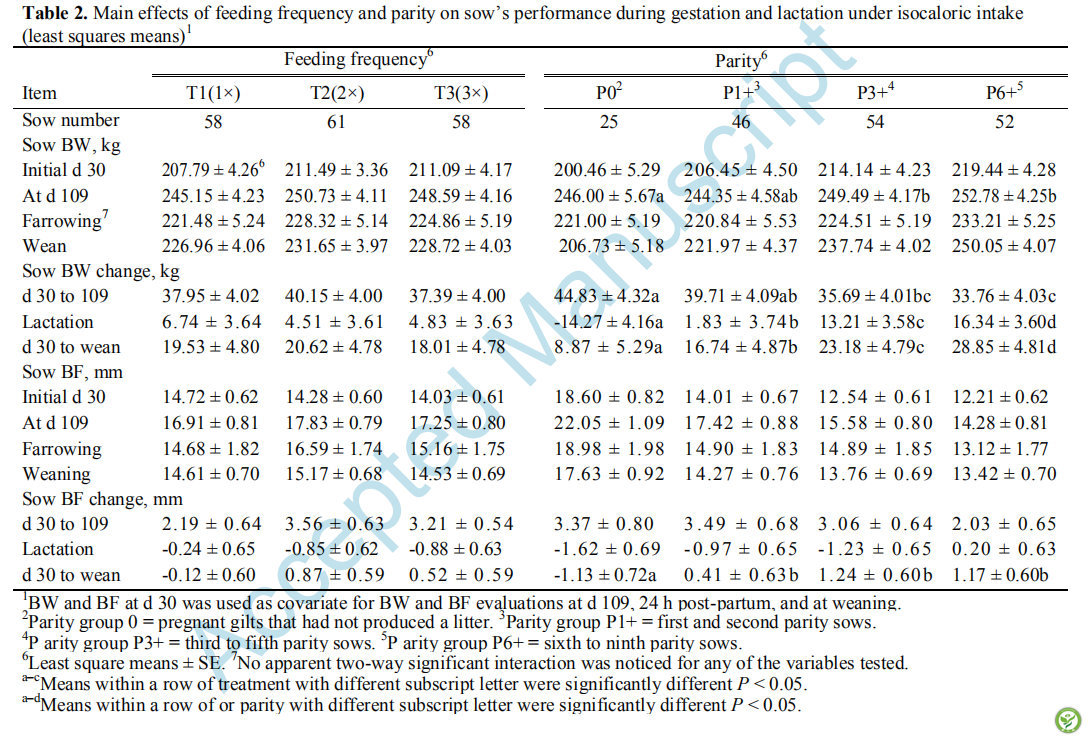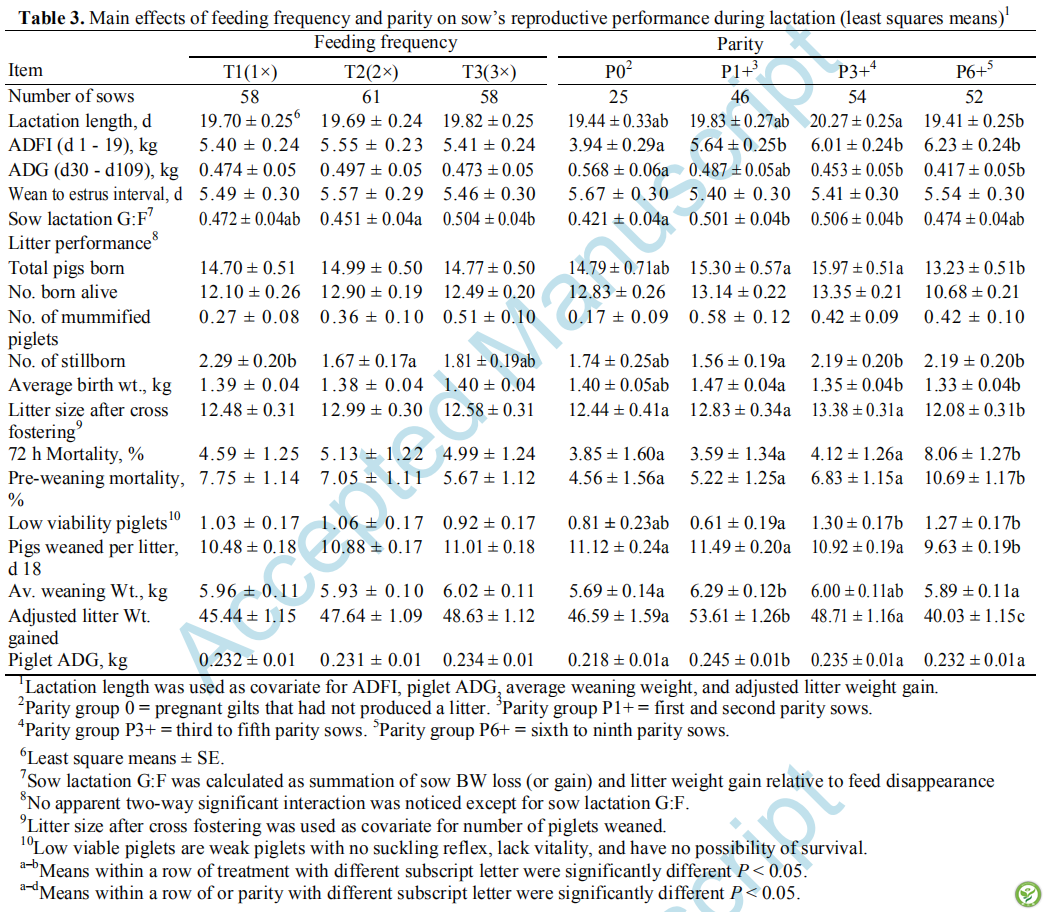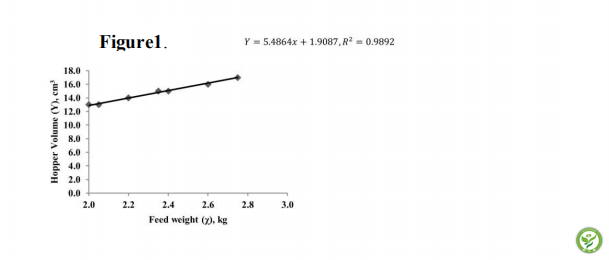第81期:妊娠期增加饲喂频率和胎次对死胎数量和断奶活仔数的影响
Effect of feeding frequency and sow parity based on isocaloric intake during gestation on sow performance
作者:Hayford Manu*, Su H. Lee§, Ping Ren*, Devi Pangeni*, Xiaojian Yang†, and Samuel K. Baidoo*†2
*Department of Animal Science, University of Minnesota, St. Paul, MN 55108; §Department of Swine and Poultry Science, Korea National College of Agriculture and Fisheries, Jeonju 54874, Korea;
†Southern Research and Outreach Center, University of Minnesota, Waseca, MN 56093
来源:J Anim Sci. 2019 Apr 29;97(5):2154-2164. doi: 10.1093/jas/skz099.
翻译:肠动力研究院 梁琦
【摘要】为进一步降低饲养成本,提高母猪的繁殖性能、养分利用率,改善动物福利,本文旨在研究妊娠期间等能量摄入下饲喂频率和胎次对母猪生产性能的影响。177头母猪(托佩克和Norsvin 70 长×大 胎次:3.80±0.16;初始体重(BW):211.34±3.37kg;背膘(BF):13.57±0.54mm)根据胎次、体重,随机分配成3个处理组。处理方式如下:母猪每天喂食含有玉米-豆粕的基础日粮,每日1次,时间在7:30(对照,T1);每日2次,时间定在07:30和15:30(T2);或每日3次,时间在7:30,11:30和15:30(T3)分别饲喂。每日饲料量保持在1.25×维持能量摄入量(100×(BW)0.75)kcal ME/d。母猪于妊娠第30天开始试验,同时在第30-60天,第61-90天,第91-109天分别平均喂食6921,7129和7399 kcal ME/d的日粮。结果显示,妊娠期饲喂频率对哺乳期母猪的平均日采食量(ADFI)无显著影响(P> 0.10)。与喂食2次/d相比,妊娠期喂食3次/d母猪的哺乳期的增重耗料比(G:F)显著提高(P = 0.040),但与对照母猪相似(P = 0.338)。在妊娠期、哺乳期或从妊娠第30天到断奶期间,处理组没有改变BW或BW的变化(P = 0.10)。从妊娠第30-109天,喂食2次/d的母猪都有增加BF的倾向(P = 0.053),但相对于对照组母猪,在哺乳期间则倾向于失去BF(P = 0.091)。与对照母猪相比,饲喂频率(2次/d和3次/d)使断奶仔猪数量增加0.40(P = 0.056)和0.53(P = 0.098)。除此外还发现,相对于对照组母猪,妊娠期间喂食2次/d的母猪的死产数量显著减少(P = 0.035)。从妊娠第30天到断奶,相对于1胎以上的母猪(P1+),后备母猪倾向于降低BF(P = 0.094),但与母猪(P3 +,P6 +)相比则表现出显著降低BF的趋势(P = 0.003)。在产后72小时和断奶前,与母猪(P0,P1 +和P3 +)相比,母猪(P6 + ,P8 +)所产仔猪的死亡率显著更高(P <0.05)。研究结果表明,1)相对于胎次较低的母猪,母猪(P6 +)哺乳期体重增加更多和但仔猪死亡率更高;2)从妊娠第30-109天,饲喂2次/d的母猪倾向于增加背膘,并且相对于对照组其死胎数量减少;3)尽管母猪的大部分繁殖性能未受影响,但妊娠母猪的饲喂频率从1次/d增加到2次/d或3次/d可以减少死胎数量并增加断奶活仔数。
【关键词】体重,饲喂频率,等能量摄入,妊娠母猪,母猪胎次,母猪生产性能
以下是相关图表
图1:妊娠期和哺乳期日粮的成分和营养成分分析,以饲喂为基础。

图2:等热量摄入下,妊娠和哺乳期间喂养频率和胎次对母猪生产性能的主要影响(最小二乘法)

图3:泌乳期间,饲喂频率和胎次对母猪繁殖性能的影响(最小二乘法)

图1:离散曲线

结论
在每千克BW0.75的等热量条件下,喂养频率对母猪妊娠期间的BW变化,哺乳期采食量,分娩时的产仔数,仔猪初生重和哺乳期结束时母猪的增重没有影响。与对照母猪相比,妊娠期间,母猪饲喂2次/d倾向于增加BF厚度并减少死产数量。与喂食1次/d的母猪相比,妊娠期间喂养频率2次/d和3次/d的母猪有可能提高断奶仔猪的数量。在每千克BW0.75的等热量条件下,母猪胎次不影响妊娠期BF变化,尽管后备母猪的增重最大。母猪(P6 +)在哺乳期间的体重增加最多,但与较年轻的母猪相比,死产数量增加,72h内和断奶前的死亡率更高。
Abstract
The aim of this study was to investigate the effect of feeding frequency and sow parity based on same rate of maintenance energy intake during gestation on sow performance. One hundred and seventy-seven sows (Topigs Norsvin 70, Landrace × Large White, Topigs Norsvin USA, Burnsville, MN; parity 3.80±0.16; initial BW = 211.34±3.37 kg; backfat (BF) 13.57±0.54 mm) were blocked by parity, balanced for BW and randomly assigned to 1 of 3 treatments in a randomized complete block design. Treatments included sows fed corn-soybean meal-based diet 1×daily at 0730 (control, T1), 2×daily [half ration at 0730 and 1530 h (T2)], or 3×daily [a third portion at 0730, 1130, and 1530 h (T3)], with daily feed quantity kept at 1.25× maintenance energy intake (100×(BW)0.75) kcal ME/d. Treatments were imposed from day 30 of gestation. Sows received on average 6921, 7129, and 7399 kcal ME/d from days 30 to 60, days 61 to 90, days 91 to 109 of gestation, respectively. Feeding frequency during gestation had no effect on lactation ADFI (P > 0 .10). Sows fed 3× daily during gestation had improved lactation G:F (P = 0.040) compared with sows fed 2× but similar to control sows (P = 0.338). Treatment did not alter BW or BW variations during gestation, lactation or from days 30 to wean (P ˃0.10). Sows fed 2× daily had tendency to gain BF from day 30 to day 109 of gestation (P = 0.053) but tended to lose BF during lactation (P = 0.091) relative to the control sows. Feeding frequency (2×and 3×daily) tended to increase the number of piglets weaned by 0.40 (P = 0.056) and 0.53 (P = 0.098) piglets respectively, compared with control sows. Sows fed 2×daily during gestation had reduced number of stillborn relative to control sows (P = 0.035). From day 30 to wean, gilts had propensity to lose BF relative to P1+ (P = 0.094), but lost BF compared with P3+ and P6+ sows (P = 0.003). Parity P6+ sows had highest percentage of both 72 h and pre-weaning piglet mortality than P0, P1+, and P3+ sows (P < 0.05). In conclusion, parity (P6+) had greater lactation BW gain but higher mortalities relative to lower parity sows. Sows fed 2× daily tended to gain BF from days 30 to 109 of gestation and had reduced number of stillborn relative to control sows. It appears that increasing gestation sow feeding frequency from 1×daily to 2×and 3×daily may reduce the number of stillborn and increase litter size at weaning although most of the reproductive traits were not affected.
Key words: Body weight, feeding frequency, isocaloric intake, pregnant sow, sow parity, sow performance
CONCLUSION
Under isocaloric condition per kilogram live BW0.75 , feeding frequency had no effect on BW changes during gestation, lactation feed intake, litter characteristics at farrowing, piglet’BW and gain at the end of the suckling period. Feeding gestation sows 2×daily, tended to increase BF depth during gestation and reduced the number of stillborn compared with control sows. Sows fed 2×and 3×daily during gestation exhibited a potential to improve the number of piglets weaned compared with sows on once a day feeding regime. Under isocaloric conditions per live BW0.75, sow parity did not affect gestation BF change although gilts had greatest BW gain. Parity (P6+) sows had greatest BW gain during lactation but greater number of stillborn, 72h, and pre-weaning mortalities relative to younger sows.
如您需原文,请联系本文作者和出版方,或请垂询肠动力研究院。本网站发布的所有资料将尽最大可能注明出处、作者及日期,如无意中侵犯了您的知识产权,请来信及时告知,我们将立即予以删除。
All information released by the WeChat Official Account will do its best to indicate the source, author and date. If we inadvertently infringe on your intellectual property, please inform us in time and we will delete it immediately.



